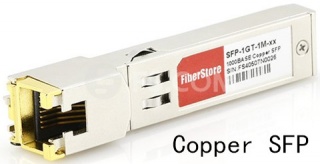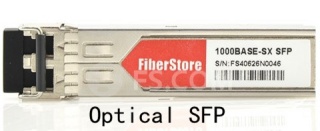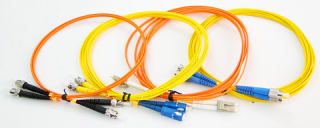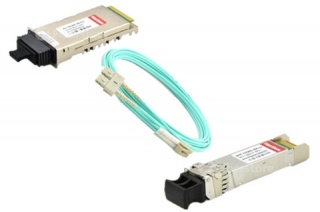C3KX-NM-10G Network Module Overview
petak , 11.11.2016.Questions like whether a 1G SFP can be used on the SFP+ port of the switch and support 10G data rate are frequently asked by overall users. Generally, you will get the answer “no”. Because Most (95+%) SFPs and SFP+s will only run at the rated speed, no more, no less. Even though SFP and SFP+ have the same port size, it doesn’t mean that you can insert a SFP in a SFP+ port to achieve a 10G connectivity. Not to mention that some SFP+ port can only support 10G SFP+ optics. However, this article will introduce a Cisco Network module in Cisco Catalyst 3750-X and 3650-X Series switches that can both support 1 GbE SFP and 10 GbE SFP+ transceivers.
C3KX-NM-10G Network Module
The Cisco Catalyst 3750-X and 3560-X series switches support four optional network modules for uplink ports, namely C3KX-NM-1G (four GbE port network module), C3KX-NM-10G (two 10GbE SFP+ ports network module with four physical ports with two SFP+ and two regular SFP ports), C3KX-NM-10GT (two 10GB-T ports network module), C3KX-SM-10G (service module with two 10GbE SFP+ ports network module for Netflow and MACsec encryption). C3KX-NM-10G module on the Cisco Catalyst 3750-X and 3560-X has two installation screws on each side, which make it easy to switch things out and make new connection without a fuss. What’s more, when business demands changes, the C3KX-NM-10G network module allows customers to only upgrade their modules from 1 GbE to 10 GbE without replacing a comprehensive upgrade of switch.
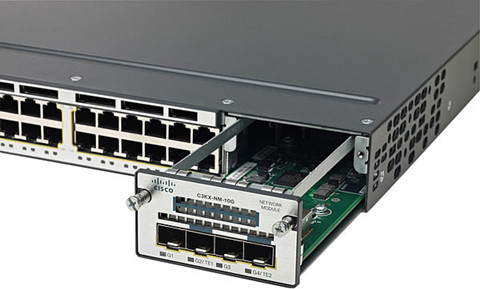
As the above image shows, the C3KX-NM-10G network module has four slots—two SFP+ slots and two SFP slots. These four slots usually work in pair, with one pair supporting 1 GbE data rate and the other achieving 10 GbE. Note that you must use the same form factor transceiver in a pair and never mix the SFP module with SFP+ module. SFP+ can’t auto-negotiate down to 1G to support with SFP module.
To put it simply, let’s name the port from left to right as slot 1, slot 2, slot 3, slot 4. Usually a 10-Gigabit SFP+ module takes precedence over a 1-Gigabit SFP module. But it’s another case when an SFP module is first inserted in Slot 1 and has link. For example, if the SFP in Slot 1 retains link, you insert an SFP+ module in Slot 2 and it will not operate. If the SFP module in Slot 1 is shut down or removed, the SFP+ module in Slot 2 turns on. The SFP module in Slot 1 does not work as long as an SFP+ module is in Slot 2. The following chart concludes the accessible combination of SFP and SFP+ modules.
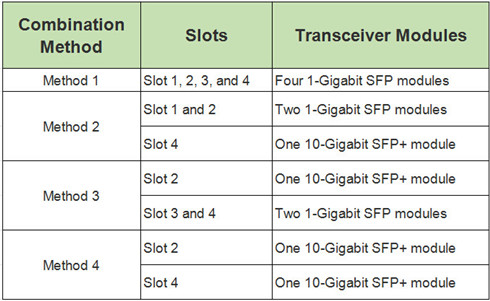
Suitable Cisco Transceivers for C3KX-NM-10G Network Module
As note before, C3KX-NM-10G module on the Cisco Catalyst 3750-X or 3560-X series switch can both support 1 Gigabit Ethernet and 10 Gigabit Ethernet data links. We will list the available Cisco modules attached with detailed information in the below charts.
Cisco SFP transceiver for C3KX-NM-10G module:
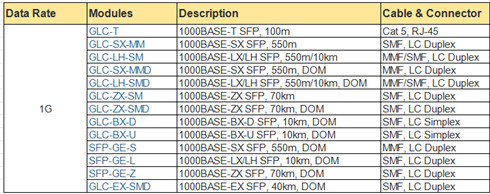
Cisco SFP+ transceiver for C3KX-NM-10G module:

There are many other compliant Cisco SFP+ DAC and AOC cables that I haven’t listed above, if you are interested, you can visit fs.com.
Conclusion
This post lists all of the functions of the Cisco C3KX-NM-10G network module, all the basic and advanced features and tells you how to select the compliant Cisco SFP modules and SFP+ modules. If you want to expand your database from 1GbE to 10GbE, with the Cisco C3KX-NM-10G network module, you only need to upgrade your Cisco SFP and plug it with a brand new SFP+ transceiver, then that’s it.
Oznake: C3KX-NM-10G, SFP, Cisco SFP
komentiraj (0) * ispiši * #
Introduction to 10GBASE-LR and 10GBASE-LRM SFP+
srijeda , 26.10.2016.Although the 40G/100G optical modules are on the very top trend for enterprise and data center for the interconnection, 10G transceiver modules are still in great demand. There are several types of 10G optical transceiver modules available for sale including the XENPAK, X2, XFP, small form-factor pluggable plus (SFP+) transceiver, of which 10g SFP transceiver (due to its small size and low power) is the most popular type for 10G network. According to the 10 Gigabit Ethernet standard, SFP+ transceiver can be classified into many categories: 10GBASE-SR SFP+, 10GBASE-LR SFP+, 10GBASE-ER SFP+, and 10GBASE-LRM SFP+. This article will focus on the introduction of the 10GBASE-LR SFP+ and 10GBASE-LRM SFP+ transceivers.
10GBASE-LR SFP+
10GBase-LR can support up to 10km over single-mode fiber and uses 1310nm lasers. There is no minimum distance for LR, either, therefore it is suitable for short connections over single mode fiber too. The Cisco 10GBASE-LR module supports a link length of 10 kilometers on standard single-mode fiber (SMF, G.652). FS.COM compatible 10GBASE-LR SFP+ transceiver possesses the same function as the original one with a much lower price than Amazon and ebay. The following image shows a Cisco Compatible SFP-10G-LR SFP+.
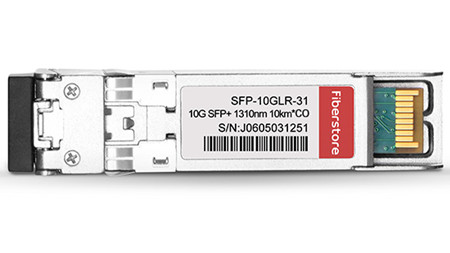
10GBASE-LRM SFP+
10GBASE-LRM still uses the 1310nm lasers, but it can only reach up to 220m over standard multimode fibers. The 10GBASE-LRM can be packaged in XFP and SFP+ form factors. FS.COM Cisco SFP-10G-LRM Compatible 10GBASE-LRM SFP+ supports link lengths of 220m on standard Fiber Distributed Data Interface (FDDI) grade multimode fiber (OM3/OM4). Every transceiver is individually tested on a full range of Cisco equipment and passed FS.COM’s testing with 100% compatibility. The following image shows a Cisco Compatible SFP-10G-LRM SFP+.
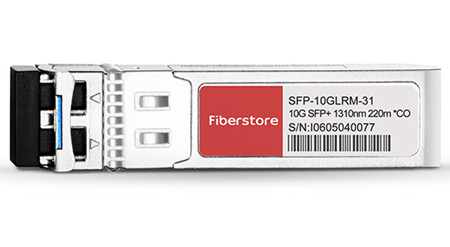
Besides the Cisco SFP-10G-LRM, there are a new type of the 10G SFP+ module for multimode fibers—SFP-10G-LRM2. It is a type of SFP+ transceivers compatible with the 10GBASE-LRM standard. SFP-10G-LRM2 can reach up to 2km over standard multimode fiber.
Contrast Between 10GBASE-LR and 10GBASE-LRM SFP+
At the first glimpse of the two terms—10GBase-LR and 10GBase-LRM, people usually have the misconception that they are similar with each other. In fact, 10GBase-LR and 10GBase-LRM meets different demands just as described in the above article. SFP-10G-LR optics (compatible with 10GBase-LR) supports a link length of 10km on standard single-mode fiber (SMF). SFP-10G-LRM (compatible with 10GBase-LRM) optics supports link lengths of 220m on standard Fiber Distributed Data Interface (FDDI) grade multimode fiber (MMF). When you use the OM1 or OM2 fibers connected with the 10GBase-LRM module, to make sure that specifications are met over FDDI-grade, the transmitter should be coupled through a mode conditioning patch cord. But it is fine when you use over the OM3 and OM4 fibers.
Conclusion
10G SFP+ transceiver is widely used to support communication standards including synchronous optical networking (SONET)/synchronous digital hierarchy (SDH), 10 Gigabit Ethernet and fibre channel. Both 10GBASE-LR and 10GBASE-LRM SFP+ wins its own place on the market. They cannot substitute for each other! FS.COM offers various compatible SFP+ transceivers for data centers, enterprise wiring closets, and service provider transport applications. 10G-SFP-SR, 10G-SFP-LR, 10G-SFP-LRM, 10G-SFP-LRM2, 10G-SFP-ER, 10G-SFP-ZR are all available in FS.COM. All of our SFP+ transceivers are tested and fully compatible with major brands like Cisco, HP, Juniper, Brocade and Finisar. For more information about 10G SFP+ modules, please visit fs.com.
Oznake: 10GBase-LR SFP+, 10GBASE-LRM SFP+, XENPAK, X2, XFP, SFP, 10G-SFP-SR
komentiraj (0) * ispiši * #
10G Data Center Cabling Solutions
srijeda , 07.09.2016.The rapid development in data center throughput has led to the increasing usage and demand for higher-performance servers, storage and interconnects. And the old 1G Ethernet cannot handle the heavy-loaded solutions in data center any more. As a result, datacenter designers are looking to the expansion of higher speed Ethernet solutions, specifically 10 G and 40G Ethernet. As for 10GbE, there are two broad categories—SFP+ optical options and 10GBASE-T available on the market, which pose difficulty in selecting the appropriate 10-gigabit physical media. This article will make a brief introduction to these two 10G solutions to help you choose the suitable one.
What Is 10G SFP+?
10G Small-form-factor pluggable plus (SFP+) is the industry standard for data rates up to 10 Gbps, which is also MSA compliant. SFP+ module is especially standardized for 10 Gbps application, and is identical in dimensions to the SFP. To achieve the SFP+ form factor reduction, only the optical-to-electrical and electrical-to-optical conversion functionalities occur inside the optical module. The key advantage of SFP+ over the existing 10 G optical interconnects is the higher port densities enabled by its dimensions, and lower power consumption. Figure 1 shows a SFP+ modules connected with a LC to LC patch cord.
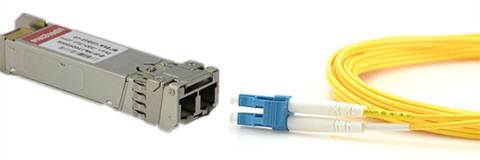
SFP+ transceivers are available in different 10G Ethernet standards—10GBASE-SR, 10GBASE-LR, 10GBASE-LRM, 10GBASE-ER, 10GBASE-ZR, 10GBASE-LX4 and 10GBASE-PR. Each standard has a unique specification that can be suitable for different applications. SFP+ optics are selected more often when designers need faster and more reliable solutions to handle 10 Gigabit Ethernet optical lines. With lower power usage and low latency, SFP+ ports are most commonly used for enterprise switches and also for plug-in cards for servers.
How Does 10G Copper Solutions Compare?
10G Ethernet can also run over twin-axial cabling, twisted pair cabling, and backplanes. SFP+ direct attach cable, 10GbASE-CX4 and 10GBASE-T are the common copper solutions for 10G short-reach interconnect. 10GBase-CX4 achieves the aggregate rate of 10 Gbps by transmitting over four independent cables at 3.125 Gbps. The disadvantage of this solution is the bulkiness of the cables that have eight twin-ax cables within them for a duplex link. And the bulkiness of the cables makes cable management more difficult. This becomes a significant limitation as the port densities and inter-port connection densities increase. Additionally, the number of conductors make these cables expensive compared to SFP+ cables.
10GBase-T enables 10 Gbps transmissions over Cat 6 and higher quality cables using complex signal processing and channel coding. The potential advantage of this technology is its extended reach. The extended reach and ability to enable structured cabling are not required for the short reach interconnects between servers and switches collocated in a rack. The disadvantages are its high power consumption and latency. The high latency in particular is a key limitation in latency sensitive data center and storage applications.
SFP+ Direct Attach DAC is another lower cost alternative to fiber with a limited link length of 7 meters. Additionally, it has significant power, cost, and performance advantages over the above media as explained below.
Why Use 10G DAC Cables in Data Center?
As 10 Gbps interconnects become ubiquitous in servers, providers are looking for a low cost, low power, and space efficient interconnect solution for the short reach (5-7m) links that dominate the data center environment. A length of seven meters covers all connections between server cards and switches, typically mounted on a single data center rack, and a vast majority of inter-rack connections. The SFP+ Direct Attach Copper is the 10G interconnect technology that matches these requirements, playing a vital role in enabling the next generation power and cost efficient data centers.
SFP+ Direct Attach Copper Solution
To further reduce cost and power in interconnect distances of 7 meters, which is sufficient to link server cards and switches, the SFP+ Direct Attach Copper replaces the optical modules and fiber with a passive copper cable with connectors identical to an SFP+ optical module. Figure 2 shows a SFP-H10GB-CU3M plugging in a Cisco switch. The reduction in cost and power are significant since the price of two optical modules required to support a full duplex link is approximately 10 times the cost of a fully connectorized SFP+ Direct Attach cable. In addition, the optical SFP+ modules consume around 1W each, adding 2W per port to the overall system power budget and cooling requirements.
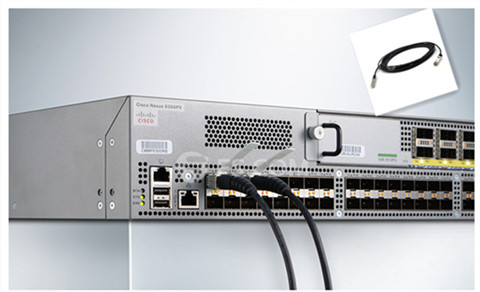
Data is transmitted as 10 G serial NRZ (Non Return to Zero) symbols with transmit pre-emphasis and receive equalization compensating for Inter Symbol Interference caused by the board trace and the copper cable. This choice of serial NRZ transmission over a passive medium makes SFP+ copper both a low power and low latency solution compared to its alternatives.
Conclusion
As more emphasis is placed on energy efficient data centers and higher bandwidth applications, the need for a small form factor, low power, low latency and low cost interconnect makes SFP+ Direct Attach the optimal solution for short-reach 10G interconnects. While SFP+ fiber options provides a great path for higher performance long haul applications. FS.COM is a top manufacturer for DAC Twinax cables (SFP+ Cables, XFP Cables, CX4 Cables, Infiniband Cables, etc) and best suppliers for QSFP+ products including 10G & 40G QSFP+ copper and AOC cables. Optics transceivers like QSFP+, SFP, SFP+, XFP, X2, XENPAK, SDH, Bidi are also offered. If you have any interest in our products, you can contact us directly.
Oznake: data center, 10G cabling, SFP, DAC cables, LC to LC patch cord, SFP-H10GB-CU3M
komentiraj (0) * ispiši * #
Copper & Optical SFP Modules
srijeda , 25.05.2016.In order to maintain the configuration flexibility and establish connections that allow smooth data transfer from the source to the end point, SFP transceiver modules are utilized in the copper or optical Gigabit Ethernet (GbE) networks. SFP (Small Form-factor Pluggable) is a compact, hot-swappable, input/output device used in data communication and telecommunications networks. SFP interfaces between communication devices like switches, routers and fiber optic cables, performing optical and electrical signal conversion. There are many copper an optical SFP transceivers based on different GbE physical layers, such as Cisco 1000BASE-T SFP-GE-T and 1000BASE-SX SFP MGBSX1.
GbE Development
The initial standard for GbE was produced by the IEEE in June 1998 as IEEE 802.3z. Two designs were ratified in IEEE 802.3z to transmit signals over optical cables: the 1000BASE-SX uses short-wavelength laser (850nm) on multi-mode fiber (MMF), and the 1000BASE-LX uses long-wavelength laser (1310nm) on the standard single-mode fiber (SMF). At that time, transmitting 1000Mbps signals on the widely deployed Category 5 UTP was a significant challenge for silicon-chip designers. It requires tremendous signal processing to mitigate the channel impairments in copper wires such as ISI (intersymbol interference) introduced by limited channel bandwidth and signal crosstalks between pairs of copper wires. It was not until a year later that the 1000BASE-T standard (IEEE 802.3ab) was finished. To keep the cost of GbE low, the IEEE 802.3z committee very conservatively defined the transmission distance limit of 1000BASE-SX as 300m, and that of 1000BASE-LX as 5 km.
SFP Port Types
Specified by the Multisource Agreement (MSA), SFP, also known as a mini gigabit interface converter (GBIC), delivers the similar functions just as what a GBIC does, but designed with a much smaller size. As mentioned above, SFP transceiver has several interfaces which are standardized to work on SMFs and MMFs. Besides, SFP transceivers are also available with copper cable interfaces, like 1000BASE-T. This means that SFP module which is designed primarily for optical fiber communications can also communicate over unshielded twisted pair (UTP) cables. The image below shows different GbE SFP standards.
Copper SFP Modules
The development of copper technology in SFP modules is of great importance in enabling system designers to meet objectives while simplifying their inventory and reducing operating costs. These copper SFP transceivers scale Ethernet 10/100Mbps performance to 1000Mbps. Compared with 1Gbps, 1000BASE-T is 100 times as fast as the standard Ethernet. Additionally, the Full Duplex Repeaters (FDRs), when coupled with 1000BASE-T, offer an easy-to-manage, high-burst rate, and shared-media solution capable of supporting both end users and server farms. Popular copper SFP products, like Cisco SFP-GE-T, are used in Gigabit networks and they are fully compatible with 1000Base-T.
Optical SFP Modules
Both 1000BASE-SX and 1000BASE-LX are standardized for fiber optics. They share the 8B/10B 1000BASE-X PCS line coding. In addition to the transmission media, the only difference between 1000BASE-SX and 1000BASE-LX lies in the physical medium dependent (PMD) layer which defines the laser transmitter and photodetector. The interface between the physical medium attachment (PMA) and PMD layer is simply a serial interface. This made it easy to reuse all the designs between 1000BSAE-SX and 1000BASE-LX except the PMD transceiver.
Modern optical SFP modules support digital diagnostics monitoring (DDM) functions, also known as digital optical monitoring (DOM). This feature gives users the ability to monitor the real-time parameters of SFP, such as optical output power, optical input power, temperature, laser-bias current and transceiver supply voltage. The real-time diagnostic parameters can be monitored to alert the system when the transceiver’s specified operating limits are exceeded and compliance cannot be ensured. What’s more, the DDM function can be used to isolate the particular location of fault in fiber optic network system. Combining the DDM interface status flags, transceiver hard pins and diagnostic parametric monitor data the specific location and cause of a link failure can be pinpointed. Certainly, DDM function also has its role in failure prediction on fiber optic links, which is based on the transceiver parametric performance., including device faults and high error rate conditions.
SFP Module Applications
Apart from GbE, SFP modules can also support other communications standards, including synchronous optical networking (SONET)/synchronous digital hierarchy (SDH), and fiber channel. They allow the transport of fast Ethernet and GbE LAN packets over time-division-multiplexing-based WANs, as well as the transmission of E1/T1 streams over packet-switched networks.
SFP Purchasing Tips
When picking such a SFP module for your network, the first important factor to be considered is the price, especially for those small and medium-sized enterprises who have a tight budget. The other points go to the product compatibility, stability, and reliability. Otherwise, no matter how low the price is, it’s of no use.
Conclusion
Copper and optical SFP modules have proven themselves as the useful devices for the increased bandwidth requirements of users with each passing day. Fiberstore supplies a wide range of SFPs to support both copper and optical interfaces. They are fully compatible with such famous brands as Cisco, Juniper, D-Link (ie. DEM-311GT). Here just lists a few for your reference. For more information about SFP modules, you can visit Fiberstore directly.
Oznake: GbE, SFP, 1000BASE-T, SFP-GE-T, 1000BASE-SX, MGBSX1, DEM-311GT, 1000BASE-LX
komentiraj (0) * ispiši * #
Patch Cable Selection Guide to Fiber Optic Transceivers
petak , 13.05.2016.Nowadays, a huge number of bandwidth-hunger devices are housed in data centers, like clustered storage systems, backup devices, and various servers, which are all connected by networking equipment. These devices need reliable and scalable cabling structure for high performance and flexibility. For some large- or middle-sized enterprises, their billion-dollar business lie in the suitable deployment of fiber patch cords and fiber optic transceivers. Since there are many kinds of patch cables available in the market for transceiver modules to promote data transmission in enterprises’ data centers, it seems a little difficult to choose the right kind for such transceivers. This text tackles this issue and provides some selection guide.
When delve into this topic, it’s imperative to have a basic understanding of the fiber optic transceiver.
Fiber Optic Transceiver Basics
Fiber optic transceiver, just as its name replies, is a self-contained component that can both transmit and receive signals. In most cases, this transceiver is plugged in devices such as routers or network interface cards which offer one or more transceiver module slot. In its whole signal transmission process, the transmitter takes an electrical input and converts it to an optical output from a laser diode or LED. The light from the transmitter is coupled into the fiber with a connector and is transmitted through the fiber optic cable plant. The light from the end of the fiber is coupled to a receiver where a detector converts the light into an electrical signal which is then conditioned properly for use by the receiving equipment.
According to different protocols, a wide range of optical transceivers are designed to support different data rates, including Gigabit SFP transceiver, 10G SFP+ transceiver, 40G QSFP+, etc..Take MGBBX1 for example, this Cisco 1000BASE-BX-U SFP is designed to be applied in Gigabit Ethernet (GbE) applications.
Fiber Patch Cord Details
Fiber optic patch cord, also called fiber jumper or fiber optic patch cable, consists of fiber optic cable terminated with different connectors on the ends. It’s typical application includes computer work station to outlet and patch panels or optical cross connect distribution center. While selecting patch cord, it’s recommended to take on from the following aspects, fiber cable mode, cable structure, connector types and so on.
Single-mode/Multi-mode Patch Cord
It’s known that fiber patch cords can be classified into single-mode and multi-mode fiber patch cord based on cable mode used. Single-mode patch cords, usually in yellow color, are with 9/125 fiber glass and has only one pathway for signal transmission, while multi-mode ones, often in orange, are with OM1 62.5/125 or OM2 50/125 fiber glass, and allow multiple pathways and several wavelengths of light to be transmitted with the large core.
Simplex/Duplex Patch Cord
According to the cable structure, patch cord can be divided into simplex and duplex versions. Simplex, also known as single strand, patch cable has one fiber, while duplex cable has two fibers joined with a thin web. Both simplex and duplex patch cords are available in single-mode or multi-mode versions. Because simplex patch cord has only one fiber link, its typically deployed for applications that only require one-way data transfer. For those applications, like fiber switches and servers, it’s advised to select duplex fiber optic cable for simultaneous and bidirectional data transfer. Additionally, there is also ribbon fan-out cable assembly (ie. one end is ribbon fiber with multi fibers and one ribbon fiber connector such as MTP connector (12 fibers), the other end is multi simplex fiber cables with connectors such as ST, SC, LC, etc.).
Patch Cord With Different Connectors
By connector type standard, fiber patch cord can also be divided. For instance, LC fiber patch cable is named as it is with LC connector. Similarly, there are SC, ST, FC, MT-RJ, E2000, MU and MPO/MTP fiber patch cables. Additionally, there are PC, UPC, APC type fiber patch cords, which are differentiated from the polish of fiber connectors.
How to Select Right Patch Cord for Transceiver?
After respective introduction to fiber optic transceiver and fiber patch cord, let’s go to the core issue—to choose the suitable cable type for transceivers.
In this part, I will take Cisco transceiver modules for example. For example, I need the suitable cable type for these two Cisco GbE transceiver modules, GLC-EX-SMD and MGBLX1. Then how to choose the right type? According to “Cisco Gigabit Ethernet Transceiver Modules Compatibility Matrix”, GLC-EX-SMD is the 1000BASE-EX SFP module that works through single-mode fiber (SMF) with LC duplex, and MGBLX1 is the 1000BASE-LX SFP module also for SMF with LC duplex. In such a case, since both two modules operate on SMF with LC connector, what I need is the with LC-LC duplex single-mode patch cable.
Conclusion
The above-mentioned example just lists one patch cable type for fiber optic transceivers. There are several commonly-aused patch cable types: LC-LC Simplex 9/125 Single-mode Fiber Patch Cable, LC-SC Duplex 9/125 Single-mode Fiber Patch Cable, LC-LC Duplex OM1 62.5/125 Multi-mode Fiber Patch Cable, ect.. Fiberstore supplies various kinds of high-quality patch cords for transceiver modules. You can visit Fiberstore for more information about patch cords.
Oznake: fiber patch cords, fiber optic transceiver, SFP, MGBBX1, MGBLX1
komentiraj (0) * ispiši * #
XFP & SFP+ 10GbE Optical Modules Overview
srijeda , 20.04.2016.To accommodate an increasing number of bandwidth-hunger applications and traffic types, an ocean of safe-proof network products have been designed and released into market, including optical modules offered to satisfy the changing and fast-growing bandwidth demands in data centers. The optical modules are devices that connect the cabling to the network, providing interface between the equipment and the cabling, sending and receiving data.
There are various transceiver types available to match each Gigabit standard. For Gigabit technology, there are two defined transceiver types: Gigabit Interface Connector (GBIC), and the “mini-GBIC” or Small Form-factor Pluggable (SFP). For 10 Gigabit Ethernet (GbE) connectivity modules, there are three types: XENPAK (and related X2 and XPAK), XFPSFP+ and SFP+. This text mainly discusses the last two 10GbE optical modules types: XFP and SFP+.
XFP & SFP+ Main Features
Optical modules refer to optical transceivers which consist of a transmitter on one end of a fiber and a receiver on the other end. XFP and SFP+ can be plugged into routers, switches, transport gear, or pretty much any network device to transmit and receive signals. They are hot swappable while the device is operating, standardized to be interchangeable among vendors, capable of operating over many different physical medium and at different distances. Being hot-swappable input/output device, XFP and SFP+ have the following main features in common.
Allow flexibility of interface choice;
Support “pay-as-you-populate” model;
Designed with strong digital optical monitoring capability;
Optical interoperability with 10GBASE XENPAK, and 10GBASE X2 on the same link;
XFP Optical Module
Protocol-independent and hot-pluggable, XFP (10G SFP) is the first small form factor 10GbE optics, typically operating at near-infrared wavelengths of 850nm, 1310nm or 1550nm with LC connector. XFP modules can provide the required optical reach over different fiber optic types (e.g. multi-mode fiber, MMF or single-mode fiber, SMF), commonly available in several categories: SR, LR, ER and ZR.
10GBASE-SR XFP
10GBASE-SR XFP (eg. XFP-10G-MM-SR) is specified to work through MMF using 850nm lasers. This XFP type supports a link length of 26m on standard FDDI-grade MMF. And when using 2000 MHz/km MMF (OM3), 300m link lengths are possible. Fiberstore compatible Cisco XFP-10G-MM-SR is able to realize 300m distance reach over OM3 with the maximum data rate at 10.3125Gbps.
10GBASE-LR XFP
10GBASE-LR XFP is designed to operate via SMF using 1310nm lasers. The maximum link length that XFP 10GBASE-SR port type can support is 10km when it’s used in combination with high-quality optics.
SFP+ Optical Module
As the result of Multi-source Agreements (MSAs) that enable equipment manufacturers to produce 802.3ae-compliant pluggable transceivers, SFP+ modules use the same physical form factor as a Gigabit SFP. It’s the enhanced version of SFP. Nowadays, SFP+ has become a popular industry format supported by many network component vendors for 10GE systems. Similar to XFP, SFP+ also has different port types, like SR, LX4, LR, and so on.
10GBASE-SR SFP+
10GBase-SR is the original multi-mode optics specification, and is still by far the most commonly used. Since it uses a single, low cost solid state laser assembly, 10GBase-SR is the least expensive of the optical modules available for a 10GbE SFP+ platform. Just like 10GBASE-SR XFP, 10GBase-SR SFP+ is very sensitive to fiber type. When using standard MMF, the possible link length supported by 10GBASE-SR SFP+ is 26m, and when deploying OM3 or 10GbE-optimized fiber, the maximum link length is 300m.
10GBASE-LX4 SFP+
To break through the distance limitations of 10GBASE-SR optics, the 10GBASE-LX4 standard was developed later. LX4 uses 4 lasers, each operating at a different wavelength at a 2.5Gbps data rate, resulting in a range of 240-300m link length which depends on cable grade. However, due to the complex laser assembly, it is not possible to get LX4 optics in SFP+ versions. With the ready availability of OM3 fiber and newer standards that provide long reach over multi-mode with a single laser, LX4 has become obsolete nowadays.
10GBASE-LR SFP+
10GBASE-LR is a port type for SMF, supporting the maximum link length of 10km. During data transmission, a single laser operating at 1310nm is used, which allows LRM optics to be packaged in XFP and SFP+ form factors.
Conclusion
I detail the information about two 10GbE optical module types—XFP and SFP+ with the hope that you when you go on the task of one of the most confusing aspects—choosing and deploying 10Gig fiber switches. Fiberstore supplies various types of 10GbE optical modules, including SFP+ and XFP (XFP-10G-MM-SR mentioned above). Besides, other Gigabit standard modules are also available in Fiberstore, such as 1000BASE SFP transceivers (eg. Juniper EX-SFP-1GE-LX). If you want to buy such an optical module for your network connectivity, you can visit Fiberstore for your reference.
Oznake: 10GbE, Cisco XFP-10G-MM-SR, SFP, Gigabit standard module, EX-SFP-1GE-LX
komentiraj (0) * ispiši * #
1000BASE-X SFP Modules Overview
ponedjeljak , 28.03.2016.A continuous stream of manufacturing process improvements and product innovations has given fiber optical system several advantages, like longer distance reach, larger data-carrying capacity, greater bandwidth and lower power consumption. Among these fiber optical product innovations, hot-pluggable transceiver modules should come to the central point with their unique designs. They have been constantly designed, and finally been reinvented as hot-pluggable modules along with the optical technological advances. These small, hot-pluggable serve as the key components in accommodating the demands of higher port density and more networking flexibility.
Transceiver modules come into various types: SFP (small form-factor pluggable), SFP+ (small form-factor pluggable plus), QSFP+ (quad small form-factor pluggable plus), etc. This article mainly introduces SFP transceiver modules which are widely applied in Gigabit Ethernet (GbE) applications, with the focus on several 1000BASE-X interface types, including 1000BASE-SX, 1000BASE-LX, 1000BASE-EX, and 1000BASE-BX10-D/U.
Features and Benefits
1000BASE-X SFP modules provide a wide range of form factor options for enterprise and service provider needs. They are designed with the following features and benefits:
Hot swappable to maximize uptime and simplify serviceability;
Flexibility of media and interface choice on a port-by-port basis, so you can “pay as you populate”;
Sophisticated design for enhanced reliability;
Supports digital optical monitoring (DOM) function;
1000BASE-X SFP Interface Types
1000BASE-SX SFP
1000BASE-SX SFP, compatible with the IEEE 802.3z 1000BASE-SX standard, operates on legacy 50Ľm multi-mode fiber (MMF) links up to 550m and on 62.5Ľm Fiber Distributed Data Interface (FDDI)-grade MMFs up to 220m. Take DEM-311GT for example, Fiberstore compatible D-Link 1000BASE-SX SFP is able to realize 550m link length through OM2 MMF with duplex LC.
1000BASE-LX SFP
1000BASE-LX SFP, compatible with the IEEE 802.3z 1000BASE-LX standard, is specified to support link length of up to 10km on standard single-mode fiber (SMF), to 550m on MMFs. When used over legacy MMF, the transmitter should be coupled through a mode conditioning patch cable. The laser is launched at a precise offset from the center of the fiber which causes it to spread across the diameter of the fiber core, reducing the effect known as differential mode delay which occurs when the laser couples onto only a small number of available modes in MMF.
1000BASE-EX SFP
1000BASE-EX, sometimes referred to as LH, is a non-standard but industry accepted standard which works on standard SMF with fiber link spans up to 40km in length. For back-to-back connectivity, a 5-dB inline optical attenuator should be inserted between the fiber optic cable and the receiving port on the SFP at each end of the link. 1000BASE-EX SFPs (eg. GLC-EX-SMD) run on 1310nm wavelength lasers, and achieves 40km link length.
1000BASE-BX10-D/U SFP
The 1000BASE-BX-D and 1000BASE-BX-U SFPs, compatible with the IEEE 802.3ah 1000BASE-BX10-D and 1000BASE-BX10-U standards, operate on a single strand of standard SMF (figure shown below). A 1000BASE-BX10-D device is always connected to a 1000BASE-BX10-U device by a single strand of standard SMF with an operating transmission distance up to 10km.
The communication over a single strand of fiber is accomplished by separating the transmission wavelength of the two devices (figure shown above): 1000BASE-BX10-D transmits a 1490nm channel and receives a 1310nm signal, whereas 1000BASE-BX10-U transmits at a 1310-nm wavelength and receives a 1490-nm signal. In this figure, the wavelength-division multiplexing (WDM) splitter is integrated into the SFP to split the 1310nm and 1490nm light paths.
Conclusion
These 1000BASE-X SFP modules provide physical layer connectivity for optical-port modular switch IO blades and optical-port stackable switches, reliable, and cost-effective choices to accommodate varied and evolving network demands. As a professional fiber optic product manufacturer and supplier, Fiberstore supplies all the above-mentioned several 1000BASE-X SFP modules which are all test- and quality-assured. You can visit Fiberstore for more information about 1000BASE-X SFP modules.
Oznake: SFP, 1000BASE-X SFPs, DEM-311GT, GLC-EX-SMD
komentiraj (0) * ispiši * #
Transceiver Selection Guide for Your Networking Use
četvrtak , 24.03.2016.Thanks to the advances made in fiber optical technologies, fiber solutions have been deployed in ever-increasing applications where high-speed and high-performance data transmission is needed. They outweigh the copper solutions in such aspects as higher bandwidth, longer distances and Electromagnetic interference (EMI) immunity. Transceivers, one of the key components required in such fiber connections for high networking performance, have experienced the never-ceasing industrial designs, from lower port density to higher, from the standard modules to the final hot-pluggable ones, to meet the ever more flexible networking infrastructure.
There is a broad selection of hot-pluggable transceiver modules available for fiber networking use, and you may feel a little confused about how to select the correct transceivers for your networking transmission. In this article, I will illustrate different aspects of transceivers that need to be known before choosing a transceiver.
Transceiver Basics
Before giving guidance to transceiver selection, it’s necessary to know the basics of transceiver. Transceiver is a combination of a transmitter and a receiver in a single package, while they function independently for bidirectional communication. Typically, a fiber optic transceiver converts the incoming optical signal to electrical and the outgoing electrical signal to optical. More specifically, the transmitter takes an electrical input and converts it to an optical output from a laser diode or LED. The light from the transmitter is coupled into the fiber with a connector and is transmitted through the fiber optic cable plant. The light from the end of the fiber is coupled to a receiver where a detector converts the light into an electrical signal which is then conditioned properly for use by the receiving equipment.
Here go the several aspects of transceivers that are helpful in your purchasing.
Form-factor
Multi-source agreements (MSAs) between different equipment vendors specify guidelines for electrical and optical interfaces, mechanical dimensions and electro-magnetic specification of a transceiver. The equipment vendors follow these MSA defined values for designing their systems to ensure interoperability between interface modules. The form-factor or the MSA-type is needed so that the transceiver can mechanically and electrically fit into a given switch, router, etc. Transceiver MSAs define mechanical form factors including electric interface as well as power consumption and cable connector types. There are various MSA types: SFP (eg. MGBSX1), SFP+, XFP, CFP, CFP2, CFP4, QSFP and so on.
Transmission Media
Transceivers can work over single-mode fiber (SMF), multi-mode fiber (MMF), and copper. In different Ethernet applications, media can achieve different link lengths when combined with transceivers. Take Gigabit Ethernet (GbE) applications for example, single-mode transceivers can have a transmission distance of 5km to 120km, while multi-mode transceivers are defined to have the maximum reach of 55om, with copper solution establishing even fewer link length at 25m. Take MGBLX1 for example, this Cisco compatible 1000BASE-LX SFP works through SMF for 10km reach.
Power Budget
The transceiver power budget is the difference between transmitter launch power and receiver sensitivity and has to be 2-3dB larger (Margin) than the measured link loss. If the link loss cannot be measured, it has to be calculated. Therefore transmission distance [km], the number of ODFs, patches and passive optical components (Muxes) have to be known. Common values for power budget are <10, 14, 20, 24, 28, >30dB.
If you’re seeking high-speed data carrier, transceivers can help accomplish goals. By transmitting data at 10Gbit/s, 40Gbit/s, 100Gbit/s or 12940Gbit/s, they can ensure that data arrives quickly. Transceiver modules that are capable of handling fast speeds can help with downloads and high and low bandwidth video transmission.
Conclusion
Transceivers are instrumental in ensuring that the data is transmitted securely, expeditiously, and accurately across the media. Choosing the right type of transceiver for your network is not always easy, but knowing above discussed parameters beforehand helps you narrow it down to a few transceivers. Fiberstore offers a sea of transceiver modules which are fully compatible with major brands, like the above mentioned MGBSX1 and MGBLX1, the Cisco compatible transceiver modules. For more information about transceiver modules, you can visit Fiberstore.
Oznake: transceivers, MSAs, SFP, MGBSX1, compatible transceiver modules, MGBLX1
komentiraj (0) * ispiši * #
Considerations About Fiber Optic Transceiver Designing
utorak , 22.03.2016.The rapid expansion of fiber optic networks, including data services measured by data volume or bandwidth, shows that fiber optic transmission technology is and will continue to be a significant part of future networking systems. Network designers are becoming increasingly comfortable with fiber solutions, since the use of which allows for more flexible network architecture and other advantages, such as EMI (Electromagnetic Interference) resilience and data security. Fiber optic transceivers play an really important role in these fiber connections. And while designing fiber optic transceivers, three aspects need to be considered: environmental situation, electrical condition and optical performance.
What Is a Fiber Optic Transceiver?
The fiber optic transceiver is a self-contained component that transmits and receives signals. Usually, it is inserted in devices such as routers or network interface cards which provide one or more transceiver module slot. The transmitter takes an electrical input and converts it to an optical output from a laser diode or LED. The light from the transmitter is coupled into the fiber with a connector and is transmitted through the fiber optic cable plant. Then the light from the end of the fiber is coupled to a receiver where a detector converts the light into an electrical signal which is then conditioned properly for use by the receiving equipment. There are a full range of optical transceivers available in telecommunication market, like SFP transceiver, SFP+ transceiver (eg. SFP-10G-SR shown below), 40G QSFP+, 100G CFP, etc.
Designing Considerations
It’s true that fiber links can handle higher data rates over longer distances than copper solutions, which drive the even wider use of fiber optic transceivers. While designing fiber optic transceivers, the following aspects should be taken into consideration.
Environmental Situation
One challenge comes to the outside weather—especially severe weather at elevated or exposed heights. The components must operate over extreme environmental conditions, over a wider temperature range. The second environmental issue related to the fiber optic transceiver design is the host board environment which contains the system power dissipation and thermal dissipation characteristics.
A major advantage of the fiber optic transceiver is the relatively low electrical power requirements. However, this low power does not exactly mean that the thermal design can be ignored when assembling a host configuration. Sufficient ventilation or airflow should be included to help dissipate thermal energy that is drawn off the module. Part of this requirement is addressed by the standardized SFP cage which is mounted on the host board and also serves as a conduit for thermal energy. Case temperature reported by the Digital Monitor Interface (DMI), when the host operates at its maximum design temperature, is the ultimate test of the effectiveness of the overall system thermal design.
Electrical Condition
Essentially, the fiber transceiver is an electrical device. In order to maintain error free performance for the data passing through the module, the power supply to the module must be stable and noise-free. What’s more, the power supply driving the transceiver must be appropriately filtered. The typical filters have been specified in the Multisource Agreements (MSAs) which have guided the original designs for these transceivers. One such design in the SFF-8431 specification is shown below.
Optical Performance
Optical performance is measured as Bit Error Rate, or BER. The problem facing designing optical transceiver lie in the case that the optical parameters for the transmitter and receiver have to be controlled, so that any possible degradation of the optical signal while traveling along the fibers will not cause poor BER performance. The primary parameter of relevance is the BER of the complete link. That is, the start of the link is the source of the electrical signals which drive the transmitter, and at the end, the electrical signal is received and interpreted by the circuitry in the host by the receiver. For those communication links which use optical transceivers, the primary goal is to guarantee BER performance at different link distances, and to ensure broad interoperability with third party transceivers from different vendors.
Conclusion
Fiber technology is becoming maturer, leading to the wider use of fiber optic transceivers. With the three aspects mentioned above in mind, designing fiber optic transceivers should be easier. Fiberstore supplies many transceivers which are fully compatible with major brands, including HP compatible transceivers (eg. J4858C). For more information about fiber optic transceivers, you can visit Fiberstore.
Oznake: fiber optic transceiver, SFP, SFP-10G-SR, compatible transceivers, J4858C
komentiraj (0) * ispiši * #
Consider Two Things Before Deploying 10 Gigabit Ethernet
utorak , 08.03.2016.Over the years, Ethernet technologies have evolved rapidly and amazingly to meet the never-ceasing requirements of higher bandwidth and faster data transmission speeds for high quality network applications, such as live video and video download with high resolution. Through this great evolution, Ethernet technology standards have been designed, like 10 Gigabit Ethernet (GbE).
After IEEE Standard 802.3ae- 2002 for 10GbE was ratified several years ago, some enterprises have begun to deploy 10GbE in their data centers to support bandwidth-needing applications. Before deploying 10GbE, as matter of fact, there are many things that should attract your attention. Here this article lists two important things you need to consider for a reliable 10GbE deployment: 10GbE cabling choices, and 10GbE transceiver types.
10GbE Cabling Choices
Along with the technological revolution, cables used for transmission also experienced progressive development. There are two physical media available for 10GbE transmission: fiber and copper.
10GbE Fiber Cabling Choices
Fiber cables fall on two classifications: single-mode fiber (SMF) and multi-mode fiber (MMF). In SMF, there is only one path for light, while in MMF light flow through multiple paths. SMF is intended for long distance communication and MMF is used for distances of less than 300 m. Commonly used 10GbE ports designed for SMF are 10GBASE-LR, 10GBASE-ER and 10GBASE-ZR, and the ports specified for MMF are 10GBASE-SR and 10GBASE-LRM. It’s of great importance to choose these ports 10GbE transmission when link lengths matter. For example, you can choose a J9150A transceiver when the required distance is less than 300m. In a word, the form factor options depend on your link lengths.
10GbE Copper Cabling Choices
As the structured cabling techniques become mature, copper cabling technology also grasps the chance to develop itself. And more and more people start to choose copper cables as the medium for 10GbE transmission. 10GBASE-T and SFP+ direct attach cables (DAC) standards symbolize copper applications.
10GBASE-T, or IEEE 802.3an-2006, is a standard released in 2006 to provide 10Gbit/s connections over unshielded or shielded twisted pair cables, over distances up to 100 metres (330 ft). It requires the Cat 7 or Cat 6A to reach 100 meters, but can still work on Cat 6, Cat 5E, or even Cat 5 cable when reduced distances are required.
SFP+ DAC is the latest standard for optical transceivers, and it connects directly into an SFP+ housing. In SFP+ DAC cabling assembly, no optical transceiver is used at each end. A cable was invented with each end physically resembling a SFP+ transceiver, but with none of the expensive electronic components. This creation is known as DAC. Actually, besides 10GbE applications, DAC is also considered as a cost-effective solution to replace fiber patch cables sometimes in 40GbE systems. Like QSFP-H40G-ACU10M, this Cisco 40G cabling product is the QSFP to QSFP direct attach passive copper cable assembly designed for 40G links.
10GbE Transceiver Types
After choosing cables, you need to select devices that connect these cables to your networks. These devices are transceivers. 10GbE has four transceiver types: XENPAK (and related X2 and XPAK), GBIC, SFP and SFP+.
XENPAK is a Multisource Agreement (MSA) that defines a fiber-optic or wired transceiver module which conforms to the 10 Gigabit Ethernet (10GbE) standard of the Institute of Electrical and Electronics Engineers (IEEE) 802.3 working group.
GBIC stands for Gigabit Interface Converter. It is a common type of optical transceiver module which converts serial electric signals into serial optical signals and vice versa. The GBIC is typically employed in fiber optic and Ethernet systems as an interface for high-speed networking. Common applications include Fibre Channel and Gigabit Ethernet.
SFP (small form-factor pluggable) can be regarded as the upgrade version of GBIC module. Unlike GBIC with SC fiber optic interface, SFP is with LC interface and the main body size of SFP is only about half of GBIC so that it can save more space. There are several types of SFP modules, SX, LX, EX, etc. Among them, 1000BASE-SX SFP is the most widely used. This type works with multi-mode fiber (MMF) for linking. When used with 62.5 micron MMF, its max-working span is around 220 meters, while when used with 50 micron MMF, its max-working span is around 550 meters. Fiberstore compatible Cisco SFP-GE-S product is designed to realize 550 -meter reach through 50 micron MMF.
SFP+, also called SFP Plus, is short for enhanced small form-factor pluggable, an enhanced version of the SFP that supports data rates up to 16Gbit/s.
Conclusion
After discussion, maybe you have obtained a better understanding of 10GbE cables and transceivers, which helps you to better choose the right devices for your 10GbE applications. Fiberstore supplies various numbers of 10GbE cables and transceivers which are quality assured. For more information about 10GbE solutions, you can visit Fiberstore directly.
Originally published at www.fiber-optic-components.com/consider-two-things-before-deploying-10-gigabit-ethernet.html
Oznake: 10GbE cabling, SFP+ DAC, QSFP-H40G-ACU10M, SFP, 1000BASE-SX, SFP-GE-S
komentiraj (0) * ispiši * #

